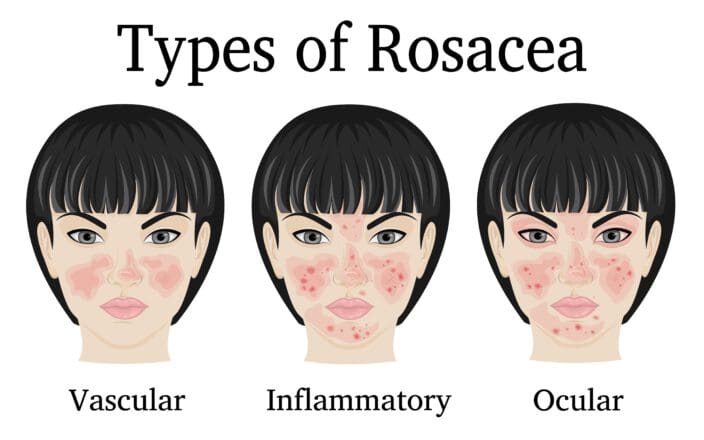Guide to Ocular Rosacea: Treatment and More
Home / Eye Conditions & Eye Diseases /
Last Updated:
Red, pulsing skin dotted with bright veins is the hallmark of rosacea. But this condition can do more than just redden your skin. It can also add a rosy tinge to your eyes, and sometimes, that eye redness is the first sign of rosacea you will see.
Table of Contents
More than half of all people with rosacea have the ocular form of the disease. In addition to changing your eyes’ color, it can also deliver a sense of dryness or grittiness. If left untreated, it can even steal your vision.
In the past, doctors started treatment with oral medications. Now, many professionals consider ocular rosacea a skin disorder, and they encourage patients to use therapies that unplug glands that surround the eyes.
But rosacea can also touch the inside of your eye, especially if it’s left untreated for an extended period. For some people, eye drops are a crucial part of recovery. Lifestyle changes may also help to keep symptoms under control.

What Is Rosacea?
Rosacea is a chronic condition that causes inflammation, redness, and blocked pores. People with rosacea tend to develop a band of bright-red skin that stretches from one cheek to another, and that tissue may be tender or itchy.
The National Rosacea Society says 5.46 percent of people worldwide have rosacea, although that number can vary depending on whether researchers are counting cases verified by dermatologists or those cited by patients.
You deserve clear vision. We can help.
With 135+ locations and over 2.5 million procedures performed, our board-certified eye surgeons deliver results you can trust. Your journey to better vision starts here.
There is no blood test or skin scraping that can confirm a rosacea diagnosis. Instead, doctors examine their patients and ask questions about symptoms. They put all of the puzzle pieces together, and if they fit, they diagnose rosacea.
Often, that early conversation concerns the eyes. Per Mayo Clinic, ocular rosacea is one of the first symptoms people develop before their skin begins to change due to the disease.
Rosacea and Your Eyes

Rosacea can cause your eye color to shift from white to red. It can also cause bothersome, distracting symptoms that get worse over time. Those secondary symptoms can harm your eyes, and that could lead to vision loss.
About 60 percent of people with rosacea have ocular symptoms, says the National Rosacea Society. Those people experience:
- Redness. The eyelids and the inside of the eye can seem pink or red. Look closely, and you’ll see dilated blood vessels.
- Dryness or itchiness. You may feel as though you just can’t blink often enough to keep your eyes lubricated, and they may burn or sting.
- Sensitivity. Very bright light can hurt your eyes, even when you’re wearing sunglasses.
- Grittiness. You may feel like there’s something on the surface of your eye, although you can’t see anything there.
Your symptoms may come and go, and you may find that they worsen in specific situations. For example, if you spend the day outside in a high wind, you may feel very uncomfortable, but when you head back inside, the discomfort may ease up.
Causes
Research shows ocular rosacea is more prevalent in women than men, although doctors have yet to pinpoint the exact cause of it. However, recent studies show the most probable causes are likely:
- Bacterial infection
- Swollen blood vessels
- Hereditary (passed down from a parent)
- Environmental factors
- Eyelash mites
- Blocked glands
Ocular rosacea affects people with skin that’s sensitive to the sun more than those who are not. The condition is more severe in men and young people.
Factors that can aggravate ocular rosacea include:
- Alcohol consumption
- Saunas or hot baths
- Extreme emotions like anger
- Severe weather conditions such as wind or sunlight
Treatment Starts With the Eyelid
Rosacea is not just uncomfortable. The symptoms you are feeling stem from poor lubrication and inflammation, and both are dangerous for your eyes. In the past, doctors headed right to the medicine shelf to deliver relief. Now, therapy often starts at the sink.
Dermatologists say that their colleagues have been too quick to move past the eyelids and into the center of the eye, when many of the symptoms people experience come from damage to the eyelids.
Rosacea, they say, causes inflammation of key glands that surround the eye. When these glands are swollen, they become blocked, and that leads to ineffective tears. Each drop contains only a tiny amount of oil, so your blinks do not coat your eye with comfort.
If your eyes are not bathed with the right amount of tears for long enough, the overall health of your eyes can suffer. But in early stages of ocular rosacea, unblocking those pores and improving lubrication could be all you need to stay healthy.
Doctors can do that by encouraging you to scrub your eyelids regularly. The American Academy of Ophthalmology recommends the following:
- Dampen a washcloth with warm water.
- Mix baby shampoo with warm water, and apply that to the washcloth.
- Gently rub across your lash line.
- Use gentle pressure as needed to unblock pores.
Your doctor may also recommend applying a hot compress to your eyelids several times per day. That can help to unblock pores and increase healthy tear production.
Doctors may also use topical medications to ease inflammation, unblock pores, and increase tear production. If they work, your eyes will be less red and swollen, and you will have all the tears you need to keep the inside of your eyes healthy too.

You deserve clear vision. We can help.
With 135+ locations and over 2.5 million procedures performed, our board-certified eye surgeons deliver results you can trust. Your journey to better vision starts here.
Rosacea Can Harm Your Eyes
While researchers are hoping to encourage doctors to examine and treat the eyelid before addressing the inside of the eye with medications that do not always work, some people do develop symptoms on the surface of the eyes.
Researchers writing for Case Reports in Ophthalmology say that ocular rosacea is often misdiagnosed. People are diagnosed with other things, like:
- Infections
- Dry eye
- Blepharitis
- Allergies
Meanwhile, their eyes get dryer and dryer, and the tissue starts to die off. Some people develop very painful ulcers on the eye’s surface, and others have eye ruptures due to thinning tissue. Both of these issues can lead to vision loss.
Years ago, doctors prescribed oral antibiotics or steroids to help their patients. But these drugs can come with side effects.
- Diarrhea
- Stomach upset
- Antibiotic resistance
- Secondary infections
It’s also not clear if they are effective on issues that touch the eyes. The medications must travel a long distance from the digestive tract to the eyes, and they can lose some efficacy along the way.
Now, doctors use topical medications to help. Eye drops or ointments target the problem at the source while bypassing the digestive tract altogether.
Typically, you will use these therapies for just a few days, and then you will head back to your doctor for a checkup. If the problem does not resolve, you may need more significant treatments like surgeries to repair the damage done to your eyes.
For example, a thin, torn cornea may not heal without the help of a surgeon. In severe cases, you might need a corneal transplant. But in others, your doctor can use lasers to open up tear ducts and help bathe your eyes in the fluids they need as they heal. Not everyone with ocular rosacea needs this treatment, but some people do.

What Else Can You Try?
Rosacea cannot be cured, but you can keep symptoms under control. The same steps you take to protect your skin could also be helpful for your eyes.
If you have rosacea, you should:
- Avoid sun exposure. Use hats and sunglasses to shield your eyes when you are heading outside.
- Stay hydrated. Keep a water bottle with you and sip liberally. If your eyes feel dry, speak with your doctor about lubricating eye drops.
- Clean gently. Avoid using irritating products on your face. Perfumes, alcohol, and menthol can all irritate your skin and cause swelling.
- Be careful with makeup. Eyeliner and false eyelashes put pressure on tissues already pushed to the limit by rosacea. Talk with your doctor about your beauty routine, and look for ways to avoid irritants.
- Watch your diet. Some people with rosacea have worsening symptoms when they consume chocolate or alcohol. Your triggers might be different. Look for a link and avoid future inflammation. Probiotics may also help to treat rosacea, researchers say, as many people with this condition have unusual gut flora levels.
It’s also crucial to stay in touch with your doctor and follow your treatment plan to the letter. Since rosacea can’t be cured, it’s up to you to manage your symptoms and strive for a healthier future.
Your doctor is part of that journey. Keep your appointments, and ask if there is a part of your treatment plan you’d like to change.
FAQs About Ocular Rosacea
What causes flare-ups?
Ocular rosacea flare-ups don’t act the same for everyone. However, identifying your triggers will help you avoid them. Common reasons for an outbreak include:
- Overconsumption of alcohol
- Exposure to hot sun and wind
- Over-exercising
- Hot, spicy food and beverages
- Stress
- Extreme temperature
- Harsh facial cleansers
Can it be treated by a dermatologist?
Your best bet of beating the condition is combination care from a dermatologist and ophthalmologist. A dermatologist will educate you about treatment options, including skin ointments and education on how to avoid triggers.
A consultant ophthalmologist will prescribe antibiotic pills, artificial tears, steroid eye drops and eyelid scrubs.
What foods should you avoid?
Watching your diet is a smart way to keep rosacea’s symptoms under control. Be wary of consuming the following foods:
- Spicy and hot food
- High histamine fruits and vegetables like strawberries, pineapples, spinach, and mushrooms
- Legumes
- Fermented foods such as aged cheese
- Shellfish
- Dairy products, especially yogurt
- Chocolate
- Alcohol
You deserve clear vision. We can help.
With 135+ locations and over 2.5 million procedures performed, our board-certified eye surgeons deliver results you can trust. Your journey to better vision starts here.
References
- 415 Million People Affected by Rosacea Worldwide. (April 2018). National Rosacea Society.
- Rosacea: Diagnosis and Treatment. American Academy of Dermatology.
- Ocular Rosacea. (June 2018). Mayo Clinic.
- Ocular Rosacea: What Your Eyes May Be Trying to Tell You. (January 2015). National Rosacea Society.
- Dermatologist Calls for Paradigm Shift on Treating Ocular Rosacea. (June 2017). Internal Medicine News.
- Treatment of Ocular Rosacea: Comparative Study of Topical Cyclosporine and Oral Doxycycline. (June 2015). International Journal of Ophthalmology.
- Ocular Rosacea. (November 2018). American Academy of Ophthalmology.
- Therapeutical Management for Ocular Rosacea. (May 2016). Case Reports in Ophthalmology.
- Everything You Need to Know About Ocular Rosacea. (October 2018). Health Line.
- Eating Right for Rosacea: Answers From Dr. Chutkan. (November 2013). Everyday Health.
- Ocular rosacea. (June 2020). Mayo Clinic.
- Ocular Rosacea. (October 2020). American Academy of Ophthalmology.
- Cutaneous and ocular rosacea: Common and specific physiopathogenic mechanisms and study models. (May 2021). National Center for Biotechnology Information.
- An update on the treatment of rosacea. (February 2018). National Center for Biotechnology Information.
- ROSACEA: DIAGNOSIS AND TREATMENT. (Retrieved November 2021). American Academy of Dermatology Association.
This content is for informational purposes only. It may have been reviewed by a licensed physician, but is not intended to serve as a substitute for professional medical advice. Always consult your healthcare provider with any health concerns. For more, read our Privacy Policy and Editorial Policy.